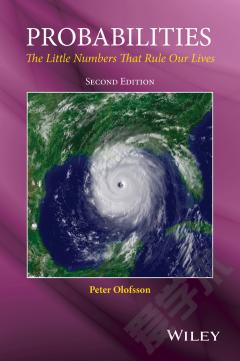Probabilities —— The Little Numbers That Rule Our Lives
----- 概率:支配我们生活的小数字 第2版
ISBN: 9781118898901 出版年:2014 页码:325 Peter Olofsson Wiley
This book is a popular and brief treatise on probability theory. No knowledge of calculus or previous knowledge of probability theory or statistics is required.
I have yet to read the book cover to cover, but from my initial skimming this book is extremely unusual in the following ways. First, it is very clear. Second, the author's style is extremely engaging and even humorous. Third, the author is pointing out properties that are very interesting, relevant, and applicable, but which the standard textbooks entirely omit. This book takes probability---a topic that is difficult for nearly every student---and it makes it much more comprehensible and accessible. There are lots of applications as well.
A great book, even for the non-math-literate. Those little numbers matter!!
I cannot say enough good things about this book and would give it more than five stars if I could. This book is a must-read for anyone even remotely interested in/connected to probability, or, for that matter, anyone who appreciates good writing. The authorâs naturally engaging style and broad scope makes this book a real treat. Moreover, each chapter is so full of interesting ideas that I felt like I learned more from this book than many much longer books. The author has a real gift for making complex concepts seem perfectly natural. Maybe this is due to my previous physics background, but I also absolutely loved how Olofsson uses extreme limiting situations to illuminate key ideas! For convenience, I included my review of the first edition below with some updates. Once I started âProbabilities,â I found I did not want to go back to Ross (the required book for my probability class at the time) even though Ross is pretty decent. Many people (including some professional mathematicians I know) do not like probability because it is often counterintuitive. However, Olofsson uses this to his advantage, highlighting the counterintuitive results as something that makes the subject so fascinatig. In fact, âProbabilitiesâ has a chapter called âSurprising Probabilities: When Intuition Struggles.â Most importantly, âProbabilitiesâ uses these counterintuitive results to help develop insight. The book often starts off with the intuitive thinking for a problem and then uses more in-depth analysis to show why it is in fact incorrect. And it makes this surprisingly fun! As far as learning outcomes are concerned, I would say that the way âProbabilitiesâ extracts insight from examples and extrapolates them to more general ideas is one of the biggest advantages it has over Ross. Whereas Ross presents a large number of miscellaneous standalone examples, Olofsson successfully builds up examples and clearly pinpoints the key to approaching them. Hereâs an illustrative excerpt from âProbabilitiesâ: *** Just like in the case of the children, there is a difference between the two pieces of information. And just like in the case of the children, there is more information in the case where something specific, in this case the ace of spades, has been identifiedâ¦In the first case, we are asking for the probability of more than one ace given at least one ace; in the second, given one particular ace. *** As another example, I was really grateful to Olofsson for pointing out that a class of problems can be easily solved through the recursive use of the law of total probability. Of course, Ross uses exactly this principle in a number of examples, but I donât believe he ever explicitly gives it a name. There is also no practical way to go through all of the examples included in Ross and skipping a key example may result in missing an important concept. I was impressed by the fact that âProbabilitiesâ managed to cover the key examples without leaving out anything major and without having anything seem like it was inserted just for the sake of completeness. Further, while Ross provides formal proofs of key results, Olofsson helps develop intuition into understanding why they actually hold. Finally, Olofsson anticipates challenges and potential misunderstandings and addresses them head-on. For instance, the section on random walks starts off with a fair game where two players flip coins, with heads meaning Player A wins and tails meaning Player B wins. It includes: *** As the game is fair, it seems reasonable to expect each player to be in the lead about half the time, with the lead passing from one to the other every now and then. Perhaps the lead changes, what, 20 times or so? Let me puncture these beliefs immediately. The most likely individual scenario is that the lead never changes and that one player is ahead all the time! *** âProbabilitiesâ is written in an informal yet sophisticated style (it does include equations). The book manages to sound natural without sacrificing clarity. It gets straight to the point without giving up a certain creativity and imagination in style. Typically, when Iâm reading a book like this, I find that there are at least a few passages that I have to re-read because they are not 100% clear the first time. Yet I cannot remember having to do this even once in this book. It helped that the author is very articulate and could draw on a wide range of knowledge outside of coins and balls in urns. I personally really appreciated the multiple references to other books on the topic. Instead of listing them in ABC order in a Bibliography at the end, Olofsson intersperses them naturally throughout the text. As an added side-bonus (for me anyway), the book included more references to Sweden than a typical book written by a US-based author, and I enjoyed these Sweden-centric details. One example was a reference to a story by Swedish humorist Tage Danielsson featuring Mr. Sven-Erik Average, which I looked up. Additionally, the generous references to pop-culture and real world events helped add to the vitality of the text. However, they werenât just randomly thrown in but helped illuminate the ideas being discusses. Due to the writing style and clarity, I preferred this book to Warren Weaverâs classic Lady Luck (still worth reading)
I have yet to read the book cover to cover, but from my initial skimming this book is extremely unusual in the following ways. First, it is very clear. Second, the author's style is extremely engaging and even humorous. Third, the author is pointing out properties that are very interesting, relevant, and applicable, but which the standard textbooks entirely omit. This book takes probability---a topic that is difficult for nearly every student---and it makes it much more comprehensible and accessible. There are lots of applications as well.
A great book, even for the non-math-literate. Those little numbers matter!!
I cannot say enough good things about this book and would give it more than five stars if I could. This book is a must-read for anyone even remotely interested in/connected to probability, or, for that matter, anyone who appreciates good writing. The author’s naturally engaging style and broad scope makes this book a real treat. Moreover, each chapter is so full of interesting ideas that I felt like I learned more from this book than many much longer books. The author has a real gift for making complex concepts seem perfectly natural. Maybe this is due to my previous physics background, but I also absolutely loved how Olofsson uses extreme limiting situations to illuminate key ideas! For convenience, I included my review of the first edition below with some updates.Once I started “Probabilities,” I found I did not want to go back to Ross (the required book for my probability class at the time) even though Ross is pretty decent. Many people (including some professional mathematicians I know) do not like probability because it is often counterintuitive. However, Olofsson uses this to his advantage, highlighting the counterintuitive results as something that makes the subject so fascinatig. In fact, “Probabilities” has a chapter called “Surprising Probabilities: When Intuition Struggles.” Most importantly, “Probabilities” uses these counterintuitive results to help develop insight. The book often starts off with the intuitive thinking for a problem and then uses more in-depth analysis to show why it is in fact incorrect. And it makes this surprisingly fun!As far as learning outcomes are concerned, I would say that the way “Probabilities” extracts insight from examples and extrapolates them to more general ideas is one of the biggest advantages it has over Ross. Whereas Ross presents a large number of miscellaneous standalone examples, Olofsson successfully builds up examples and clearly pinpoints the key to approaching them. Here’s an illustrative excerpt from “Probabilities”:***Just like in the case of the children, there is a difference between the two pieces of information. And just like in the case of the children, there is more information in the case where something specific, in this case the ace of spades, has been identified…In the first case, we are asking for the probability of more than one ace given at least one ace; in the second, given one particular ace.***As another example, I was really grateful to Olofsson for pointing out that a class of problems can be easily solved through the recursive use of the law of total probability. Of course, Ross uses exactly this principle in a number of examples, but I don’t believe he ever explicitly gives it a name. There is also no practical way to go through all of the examples included in Ross and skipping a key example may result in missing an important concept. I was impressed by the fact that “Probabilities” managed to cover the key examples without leaving out anything major and without having anything seem like it was inserted just for the sake of completeness.Further, while Ross provides formal proofs of key results, Olofsson helps develop intuition into understanding why they actually hold. Finally, Olofsson anticipates challenges and potential misunderstandings and addresses them head-on. For instance, the section on random walks starts off with a fair game where two players flip coins, with heads meaning Player A wins and tails meaning Player B wins. It includes:***As the game is fair, it seems reasonable to expect each player to be in the lead about half the time, with the lead passing from one to the other every now and then. Perhaps the lead changes, what, 20 times or so?Let me puncture these beliefs immediately. The most likely individual scenario is that the lead never changes and that one player is ahead all the time!***“Probabilities” is written in an informal yet sophisticated style (it does include equations). The book manages to sound natural without sacrificing clarity. It gets straight to the point without giving up a certain creativity and imagination in style. Typically, when I’m reading a book like this, I find that there are at least a few passages that I have to re-read because they are not 100% clear the first time. Yet I cannot remember having to do this even once in this book.It helped that the author is very articulate and could draw on a wide range of knowledge outside of coins and balls in urns. I personally really appreciated the multiple references to other books on the topic. Instead of listing them in ABC order in a Bibliography at the end, Olofsson intersperses them naturally throughout the text. As an added side-bonus (for me anyway), the book included more references to Sweden than a typical book written by a US-based author, and I enjoyed these Sweden-centric details. One example was a reference to a story by Swedish humorist Tage Danielsson featuring Mr. Sven-Erik Average, which I looked up. Additionally, the generous references to pop-culture and real world events helped add to the vitality of the text. However, they weren’t just randomly thrown in but helped illuminate the ideas being discusses. Due to the writing style and clarity, I preferred this book to Warren Weaver’s classic Lady Luck (still worth reading)

隐私声明 | 电子书 | 出版社
主办单位:中国教育图书进出口有限公司
京ICP备11007853号-12  京公网安备 11010802027623号
京公网安备 11010802027623号
Copyright ©爱学术平台 2021, All Rights Reserved






